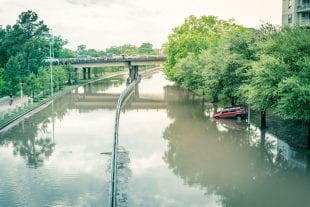Understanding climate change is key to solving the Houston area’s flooding woes, but there are major problems with the current approach, according to an environmental expert from Rice University.
Storms such as hurricanes Harvey and Ike were unprecedented, and current prediction methods are inadequate or nonexistent, argues Jim Blackburn, Baker Institute Rice Faculty Scholar and director of the Severe Storm Prediction, Education and Evacuation from Disasters (SSPEED) Center at Rice.
“We are not correctly anticipating these larger storms and currently give little to no warning to property owners, industry or adjacent residents of the true risk that these storms represent,” he writes in a new paper, “Houston Flooding 3.5 Years After Harvey.”
“Scientists must develop methodologies for foreseeing the recurrence intervals of future storms and integrate these models into future planning,” he continues. “Without such tools, much of the money being spent today on flood protection projects will not be nearly as effective as it could be.”
According to the paper, the Federal Emergency Management Agency’s 100-year flood plain map for Harris County — which state and federal agencies use when designing roads, other infrastructure projects and pollution control programs — is obsolete.
Blackburn argues that relying only upon historic patterns will underestimate future hurricanes along the Gulf Coast and East Coast. For instance, the number of hurricanes each year appears to remain fairly constant, but the storms are getting more destructive.
“Category 4 and 5 storms are becoming more abundant, with the rate of increase reported to be 25% to 30% for each 1 degree (Celsius) increase in temperature,” he wrote. “Another source indicates that the number of Category 4 and 5 storms may double by 2100. These storms are also intensifying very rapidly as seen with Harvey (2017), Irma (2017), Maria (2017) and Laura (2020), to name a few. The destruction that could be brought by a Category 5 surge of 25 feet or more up the Houston Ship Channel would be horrifying, not to mention the environmental damage and loss of life it would incur.”
Currently, storm frequency is central to all flood-related policies and programs, Blackburn explained. It’s a key element of the U.S. Army Corps of Engineers’ cost-benefit methodology and the National Flood Insurance Program.
“If we do not get this adjusted, and soon, we will not be planning for the future — we will simply be planning for the past,” he wrote. “With a changing climate, that is a losing strategy.”


